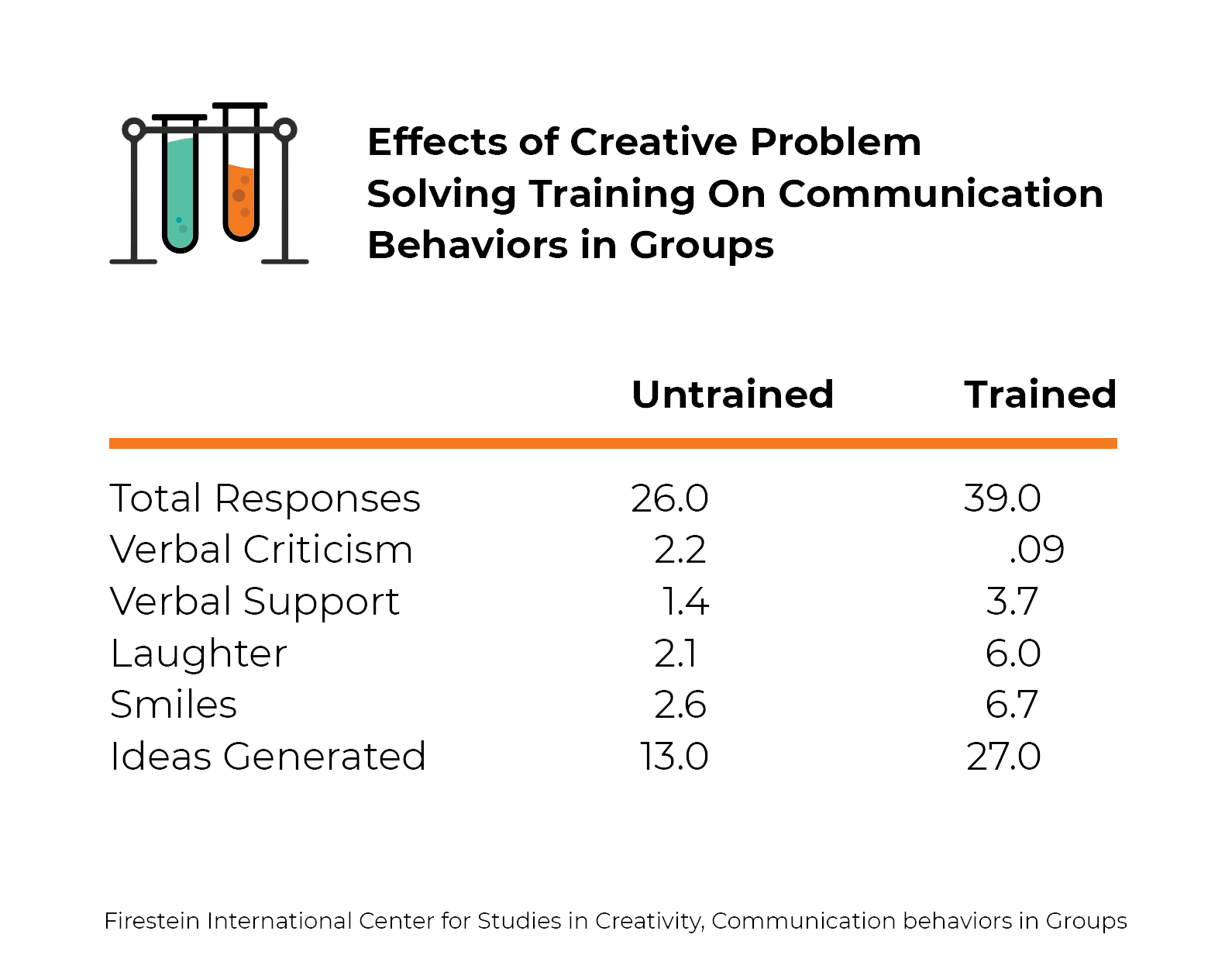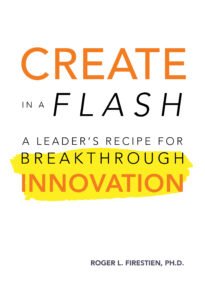Create Breakthrough Innovation
What if you could follow directions that would lead you to a place of higher innovation and creativity for you and your team?
Roger Firestien, Ph.D, is a senior faculty member at the Center for Creativity and Change Leadership at SUNY Buffalo. His new book, Create in a Flash: A Leader’s Recipe for Breakthrough Innovation, provides those directions to cultivate creativity for you and help your team to breakthrough results.
Since innovative thinking is not something that can be mandated or delegated, leaders must first develop their own creative ability before leading their organizations to create breakthroughs.
I reached out to talk with Roger about his new book and his work on innovation.
You ARE Creative
What are some of the persistent misconceptions about creativity?
Most people believe that they are not creative. Or that creativity is only associated with artists and musicians.
“I can’t draw. Therefore, I am not creative.”
This is a major misconception about creativity – and absolutely false. Creative thinking (and we all do it!) is what makes us human.
However, creativity is complex and there are many definitions of it. One of the definitions of creativity that I use is based on one developed by Dr. Morris I. Stein.
Creativity: The production of something that is novel and useful. That’s it. It’s that simple.
If that definition doesn’t do it for you. Then try these on for size.
- Creativity is a student connecting what matters in his life to a career he can pursue with passion.
- Creativity is making an already-tight budget go even further.
- Creativity is finding a better way to feed the homeless people in your city.
- Creativity is preparing a delicious meal from leftovers in the refrigerator.
- Creativity is making bedtime fun to get kiddos to sleep.
- Creativity is finding a new way to tell someone that you love them.
Have you done any of those things? Of course, you have.
That’s what creativity really is.
Is everyone creative?
Yes. Take a look at the 4-C model of creativity.
Creativity researchers James Kaufman and Ron Beghetto have identified four types of creativity. Big-C, little-c, mini-c and Pro-c.
Big-C creators are people like Albert Einstein, Frida Kahlo, and Mozart. These are the clear-cut, eminent creative contributors.
little-c is the kind of creativity that we do every day. little-c creativity is finding a way to fix machinery on the farm with just wire and duct tape, creating a delicious meal using only the leftovers in the refrigerator, or making a quilt using old clothing scraps.
mini-c is the creativity that is part of the learning process and the creativity seen in young children. mini-c focuses on the creative process. It is the new idea generated in a brainstorming session that might eventually develop into a breakthrough.
Pro-c is the creativity of individuals who are professional creators but have not reached eminent status. Pro-c is the chef who makes a living developing entrees, the musician who composes or writes new musical arrangements, the interior designer that makes your house beautiful.
If you look at the 4-C model, there is not a single person on this planet who doesn’t exhibit some form of creativity.
In fact, creativity is crucial to our survival. Imperative to create a dynamic, thriving human experience. Creativity is in all of us. You were born into this world with everything you needed to create. You are wired to be creative. You can’t help it. It is part of what makes you human.
Develop Your Creativity Skill
Is creativity a skill that can be developed?
Yes. To develop the skill of being creative, you need to think in three ways.
Divergent thinking. Exploring lots of possibilities. Generating ideas that are novel, new, ridiculous, foolish-sounding, weird, goofy, exciting.
Combinent thinking. Combine ideas across areas of knowledge. Connect ideas
that seem to be unrelated to the problem you are working on to generate novel ideas.
Convergent thinking. Most of us are pretty good at this. Select ideas, sort ideas, test and refine ideas. Make those ridiculous, foolish-sounding, exciting ideas USEFUL.
Most of us recognize divergent thinking and convergent thinking. But I have found that combinent thinking is the creativity super skill.
Most breakthroughs come by connecting things that are not usually considered connected. That’s combinent thinking. Often these connections occur as if by chance.
You are working on a tough problem, you are stymied for a solution, so you step back from the problem. You see something unrelated to your problem and you make a connection. Unfortunately, you had to wait to make that connection.
What if you could make those connections on demand? In the world of Creative Problem-Solving, or “CPS” for short, we have a technique for this. It is called Forced Connections and it is my go-to method to become deliberately creative.
Forced Connections is the practice of combining ideas that don’t appear to be related in a new way. It helps get ideas flowing when you’re stuck.
How it works:
- Consider the problem you are trying to solve.
- Pick an object or situation that is completely unrelated.
- Find or “force” a connection between the problem you are working on and the seemingly unrelated object.
The result of this connection is a new idea.
A few examples of forced connections in action include: the Nike Waffle trainer shoe was inspired by a waffle iron, the idea for the pacemaker was inspired by a flashing traffic hazard signal and the printing press was inspired by a wine press.
When I facilitate a Creative Problem-Solving session, I use a variety of pictures that I show to the group when idea generation slows down. These pictures range from a bunch of bananas, to an airplane cockpit, to a beautiful beach, to a lion in the jungle.
But you don’t need pictures to put this technique to work for you, and you don’t need a group. You just have to look around. As I write this, I am sitting at my desk. If I were working on a problem and got stuck, I would ask myself, “What ideas do I get from my smart phone? Or the books on my bookshelves, or the fan on my desk, the trees in my backyard or the model rocket that I built when I was 12?”
Using Forced Connections, the resulting ideas may not be the breakthrough you’re hoping for, but the technique gets the idea-generating process moving again so you can dig deeper for those breakthroughs.
Creativity Research
Creative Problem-Solving works. Here’s proof.
In my doctoral research I compared creative productivity using Creative Problem-Solving (CPS) trained groups and ones that were not trained in CPS.
In the study, we used 20 groups of students of five members each who had about 12 hours of CPS training. I compared them with 20 other five-member groups who were not trained in Creative Problem-Solving. We gave the students a business problem to solve and video recorded the process.
We found that the groups that were trained in Creative Problem-Solving showed a significantly higher level of participation. They criticized ideas significantly less and supported ideas significantly more. They also laughed significantly more. Did they generate more ideas? Yes! More than 2:1.
So, how about the quality of the ideas?
The groups that were trained in Creative Problem-Solving out-produced the groups that were not trained in Creative Problem-Solving on high quality ideas by over 2:1 – 618 excellent ideas to 281 excellent ideas.

Bottom Line: The trained groups had a significantly greater chance of a breakthrough occurring simply because there were more high-quality ideas generated than in the untrained group. There were more ideas, and better ideas, to choose from.
As a bonus, members of the groups trained in Creative Problem-Solving had a lot more fun generating those ideas than students in the untrained groups.
This is just one study of hundreds that proves that training in Creative Problem-Solving helps people to become deliberately creative.
Why do leaders often resist creativity but embrace innovation?
I believe the resistance to creativity has to do with the definition we hold of creativity. Here is a story of what happens to me frequently when I fly on airplanes.
You know the airplane routine. You settle into your seat. The plane takes off and the person next to you strikes up a conversation. For me it goes like this.
Passenger in seat 4A: “So, what do you do?”
Me in 4C: “I’m a creativity consultant.”
4A: The person usually frowns.
“A creativity consultant, really? Oh, I’m not creative.
So, you must be an artist. Do you teach basket weaving?”
Me in 4C: Arugh….
Same scene. Different trip. Different answer from me.
Passenger in 4A: “So, what do you do?”
Me in 4C: “I’m an innovation consultant.”
I watch 4A sit up a little straighter in his seat.
“Innovation consultant! Innovation is very important. Our business has innovation in our core values. Innovation is in our vision statement. We love innovation.”
It never fails. People value innovation, but they’re not so sure about this creativity stuff.
But here’s the thing. That’s like saying, “I want to bake a cake but I’m not so sure about this flour stuff.” There is no innovation without creativity. Creativity is the spark that ignites innovation.

What are some of the qualities of a healthy leader who develops a culture of creativity?
Here is an analogy that I like to use when I am working with leaders.
Imagine the organization you lead is a blue mountain lake. Look out over the water. What are you seeing?
Is the surface of the lake as smooth as polished glass? Or are there bubbles in the lake, some waves kicking up, a little churning here and there?
If there is action in your lake, that’s good. If it’s smooth, there is a chance that your lake is stagnant. Or worse, toxic. And who made the lake toxic, you ask?
You did.
TOXIC LEADER HEALTHY LEADER
Aloof Approachable
Takes credit Gives credit
Tells Listens, seeks ideas
Avoids debates Explores dissent and differing views
Intimidates Encourages
Rules with fear Leads with fairness
Blames others Takes responsibility
Cunning Truthful
Manipulative Allows freedom of expression
No direction Has Vision
Avoids change Open to new approaches
Moody Steady
Unaccountable Transparent
Excludes team from process Includes team in process
Judgmental Accepting and inclusive
Self-centered Selfless
Creates tension Fosters a supportive environment
Apathetic Empathetic
Plays favorites Supports team members equally
A toxic work environment leads to stagnation and apathy. So, cultivate healthy waters! Positive, forward-thinking leadership will keep the current of growth flowing in your organization.
Clarify the Problem
Your process has four steps, and let’s just touch on the first one: clarify the problem. That seems so obvious and easy yet I have seen that it isn’t as simple as it sounds. What are some of the challenges this step brings for leaders?
Leaders in organizations often loathe spending time clarifying the problem. They want to leap to generating ideas. Think about this. It does absolutely no good to generate ideas for solving the wrong problem. The problem we see is the problem we solve. Invest the time identifying the true problem.
Most people believe that creativity is coming up with a great idea. Not so. The key to creativity is solving the right problem.
We have been taught that the initial impression or definition of a problem is the real problem. We have good reason for this — school already sets up the problem for us. 2+2=4. What is the capital of Poland? Warsaw.
In my entire career, facilitating thousands of Creative Problem-Solving sessions, there has only been one occasion when the original definition of the problem was the actual problem. One out of thousands.
That’s why it is so important for you as a leader to challenge your initial impression of what you think is the problem. This is not generating ideas. Generate ideas after you have clearly identified the best problem to solve.
How do you identify the real problem? Ask lots of questions.
For example, you are doing a Google search. What is the most important thing to do? Ask a good question.
You have a tough problem to solve. What is the most important thing to do? Ask a creative question.
When you ask a good question, you get good results. Ask a lousy question you get lousy results.
The language you use to describe a problem is going to dictate the kinds of solutions you generate.
For example, “We don’t have enough money.” Good or bad question?
Answer: Bad question. In fact, it’s a statement.
When you hear that statement, your brain says, “OK, we don’t have any money.” Decision made. Move on.
“How might we raise the money for this project?”
“How might we reduce the cost of this project?”
Good and creative questions. Questions framed in this way provoke your mind to search for solutions. They tell your brain. “Let’s go find some answers. And because we are using the word ‘might,’ these can be any answers. We haven’t made any decisions yet. Look for options.”
Saying, “We don’t have enough money,” blocks your thinking and sends a message to your brain — “there aren’t any ideas out there, don’t bother looking.”
A creative question puts forth what you want to create. Not what you want to avoid.
3 Lessons in Creativity
You have had a remarkable career in creativity. Would you share just one lesson from your years of experience in industry and academia?
I would be happy, but I have three and they are short.
To benefit from being deliberately creative, train the leadership team first. It is crucial that the top members of the organization are thoroughly trained in creativity methods so they can teach their subordinates and coach the application of creativity skills.
Stick with it. When you introduce something as different as deliberate creativity, some members in your organization will hold back and not get involved. After a year or two, your leadership team might look at the program and say, “Well, we’re only getting minimal outcomes. Let’s change to another program.”
That decision trains your workforce not to participate in company initiatives. It tells obstinate employees that if they don’t participate, new efforts go away because the new initiatives have failed. Training your people to be creative on demand is a long-term investment that will serve your organization long into the future. Follow through and don’t play flavor of the month.
Keep it simple. There are many techniques to help people be deliberately creative. However, my approach has been to use a few creativity techniques, several of which I have mentioned in this interview, as my go-to creativity methods. Why? Because they always work.
When you are instilling innovation practices in your organization, don’t force people through some lock-step method, or overwhelm them with creativity tools just because they are cool or fun. Your people want to solve problems more effectively, they don’t want to become creative process junkies. You don’t need to know every part of a bicycle to ride one well.
For more information, see Create in a Flash: A Leader’s Recipe for Breakthrough Innovation.


